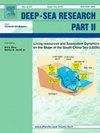太平洋帝链古岩中部段锰铁结壳成分变化及成因
IF 3
3区 地球科学
Q2 OCEANOGRAPHY
Deep-sea Research Part Ii-topical Studies in Oceanography
Pub Date : 2025-07-10
DOI:10.1016/j.dsr2.2025.105507
引用次数: 0
摘要
本文研究了皇链古岩(jingji, Ōjin,和Nintoku)中部段锰铁(Fe-Mn)结壳的形貌、矿物组成和化学成分。这些铁锰结壳以10 Å锰相为特征,与vernadite (δ-MnO2)合并,与其他太平洋海山相比,其矿物组成有显著变化。值得注意的是,这些富钴地壳的铅含量很高,浓度高达5303 ppm,平均为3029 ppm。它们显示钼(高达1429 ppm,平均为879 ppm)和钨(高达287 ppm)的含量升高,大约是全球其他海洋区域的两倍。还观察到稀土元素和钇(REY)的显著富集,累积水平为5431 ppm。锰(Mn)、铁(Fe)、钴(Co)、铜(Cu)和镍(Ni)的浓度,结合REY的分布模式,表明这些铁锰结壳主要是氢成因的。尽管如此,有证据表明热液的贡献,特别是与上新世晚期太平洋板块的火山复兴阶段(397 - 321万年前)有关。本文章由计算机程序翻译,如有差异,请以英文原文为准。
Compositional variation and genesis of ferromanganese crusts in the central segment of Emperor Chain Guyots, Pacific Ocean
We studied the morphology, mineral composition, and chemical composition of ferromanganese (Fe-Mn) crusts from the central segment of the Emperor Chain Guyots (Jingū, Ōjin, and Nintoku). These Fe-Mn crusts are characterized by a 10 Å manganese phase, amalgamated with vernadite (δ-MnO2), exhibiting significant variation in their mineralogical composition when compared to those associated with other Pacific seamounts. Notably, these Co-rich crusts are highly enriched in lead, with concentrations reaching up to 5303 ppm and an average of 3029 ppm. They show elevated levels of molybdenum (up to 1429 ppm, with an average of 879 ppm) and tungsten (up to 287 ppm), approximately double those found in other global ocean regions. A remarkable enrichment of rare earth elements and yttrium (REY) was also observed, with a cumulative level of 5431 ppm. The concentrations of manganese (Mn), iron (Fe), cobalt (Co), copper (Cu), and nickel (Ni), in combination with the REY distribution patterns, suggest that these Fe-Mn crusts are primarily of hydrogenic origin. Nonetheless, there is evidence of a hydrothermal contribution, particularly linked to the Late Pliocene volcanic rejuvenation phase (3.97–3.21 million years ago) of the Pacific Plate.
求助全文
通过发布文献求助,成功后即可免费获取论文全文。
去求助
来源期刊
CiteScore
6.40
自引率
16.70%
发文量
115
审稿时长
3 months
期刊介绍:
Deep-Sea Research Part II: Topical Studies in Oceanography publishes topical issues from the many international and interdisciplinary projects which are undertaken in oceanography. Besides these special issues from projects, the journal publishes collections of papers presented at conferences. The special issues regularly have electronic annexes of non-text material (numerical data, images, images, video, etc.) which are published with the special issues in ScienceDirect. Deep-Sea Research Part II was split off as a separate journal devoted to topical issues in 1993. Its companion journal Deep-Sea Research Part I: Oceanographic Research Papers, publishes the regular research papers in this area.

 求助内容:
求助内容: 应助结果提醒方式:
应助结果提醒方式:


